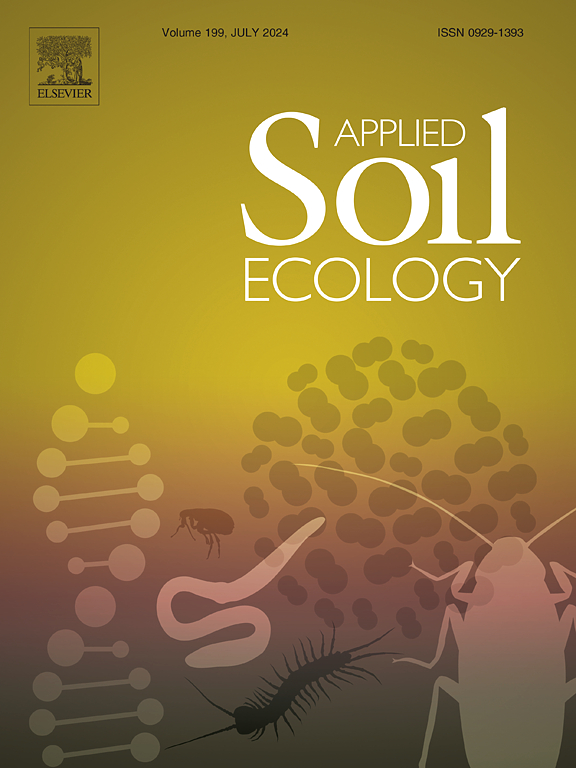Plant species richness enhances aboveground primary productivity via net biodiversity effects and bacterial community interactions
IF 4.8
2区 农林科学
Q1 SOIL SCIENCE
引用次数: 0
Abstract
The multifunctionality of grassland ecosystems is significantly affected by dominant and subdominant species, particularly in terms of aboveground primary productivity. Few studies have explored how various dominant and subdominant plant species control the interactions between several trophic levels, driving aboveground productivity. To investigate the direct and indirect drivers of productivity in dominant and subdominant plant communities, we selected three dominant and seven subdominant species from the Ningxia northern Yanchi Desert steppe for monoculture and mixture experiments to establish the richness of plant species (monoculture and 4-, 6-, 8-, and 10-species mixtures). We examined the aboveground biomass, soil properties, insect diversity, and microbial diversity of different plant species combinations, linking biotic and abiotic factors with aboveground primary productivity. We found: (1) a significant positive correlation between species richness and net biodiversity effects. Higher aboveground relative productivity was achieved for mixed species than for monoculture, particularly for Elymus dahuricus, and the selection effect had a unimodal relationship with increased species richness, with the highest productivity observed in the 8-species mixture. (2) The co-dominant insect groups in various plant species were the phytophagous Miridae, Agromyzidae, and Cicadellidae families, constituting 69.5 % of all insects collected. Plant species richness had an encouraging influence on phytophagous insect diversity, but the effects on predatory, omnivorous, and parasitic insects remained insignificant. Additionally, insect similarity indices for different plant species richness values were lower than 0.5. (3) Stoichiometric analyses of soil enzymes revealed a reduction in microbial metabolism primarily by the relative limitation of nitrogen and phosphorus, with nitrogen limitations being significantly stronger in the monoculture than in the 8-mixture species; the dominant bacterial phyla, Actinobacteria and Ascomycetes, played essential roles in promoting plant growth in desert steppes, and bacterial biodiversity influenced primary productivity more prominently than fungal biodiversity. Our findings underscore the importance of conserving species diversity and its potential benefits for ecosystem restoration and sustainability.

植物物种丰富度通过净生物多样性效应和细菌群落相互作用提高地上初级生产力
草地生态系统的多功能性受到优势种和亚优势种的显著影响,特别是在地上初级生产力方面。很少有研究探索不同的优势和亚优势植物物种如何控制几个营养水平之间的相互作用,从而推动地上生产力。为了研究优势和亚优势植物群落生产力的直接和间接驱动因素,本研究选择宁夏北部盐池荒漠草原3种优势植物和7种亚优势植物进行单栽培和混合试验,以确定植物物种的丰富度(单栽培和4、6、8和10种混合)。研究了不同植物种类组合的地上生物量、土壤性质、昆虫多样性和微生物多样性,将生物和非生物因素与地上初级生产力联系起来。结果表明:(1)物种丰富度与净生物多样性效应呈显著正相关。混合种的地上相对生产力高于单一栽培,尤以羊草为甚,且选择效应与物种丰富度呈单峰关系,8种混合种的地上相对生产力最高。(2)各植物种间共优势昆虫类群为植食性蝇科、稻蝇科和蝉科,占捕获昆虫总数的69.5%;植物物种丰富度对植食性昆虫的多样性有显著影响,但对食性、杂食性和寄生性昆虫的影响不显著。不同植物物种丰富度值的昆虫相似性指数均小于0.5。(3)土壤酶的化学计量学分析表明,土壤微生物代谢的减少主要是由于氮和磷的相对限制,其中氮的限制在单一栽培中明显强于8种混合栽培;放线菌和子囊菌是荒漠草原植物生长的优势菌门,细菌生物多样性对初级生产力的影响比真菌生物多样性更显著。我们的研究结果强调了保护物种多样性的重要性及其对生态系统恢复和可持续发展的潜在益处。
本文章由计算机程序翻译,如有差异,请以英文原文为准。
求助全文
约1分钟内获得全文
求助全文
来源期刊

Applied Soil Ecology
农林科学-土壤科学
CiteScore
9.70
自引率
4.20%
发文量
363
审稿时长
5.3 months
期刊介绍:
Applied Soil Ecology addresses the role of soil organisms and their interactions in relation to: sustainability and productivity, nutrient cycling and other soil processes, the maintenance of soil functions, the impact of human activities on soil ecosystems and bio(techno)logical control of soil-inhabiting pests, diseases and weeds.
 求助内容:
求助内容: 应助结果提醒方式:
应助结果提醒方式:


